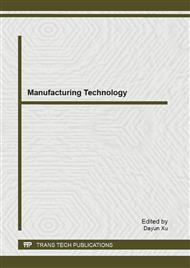[1]
McCulloch, W.S., and Pitts, W.A., A Logical calculus of the Ideas Immanent in Nervous Activity, Bull. Math. Biophysics, 943, (1943), 115-133.
DOI: 10.1007/bf02478259
Google Scholar
[2]
Kumar , Raghuvir, Experimental Observation of Crack Propagation of 6063 T6 alloy under Constant"Amplitude Loading, Int. Journal of pressure vessel and piping , (42), 1990, 293-307.
DOI: 10.1016/0308-0161(90)90029-h
Google Scholar
[3]
Singh, S.B. and Kumar Raghuvir, A Study of Fatigue Crack Growth in IS1020 Steel Under Constant Amplitude Loading, Int. Journal of pressure vessel and piping, (53), 1993, . 217-227.
DOI: 10.1016/0308-0161(93)90079-9
Google Scholar
[4]
Ishisara, S, Goshima, T, Oshimoto, Y., Sabu, T., and McEvily A.J., The Influence of Stress Ratio on Fatigue Crack Growth in a Cermet, Journal of Material Science, (35) , 2000, 5661 – 5665.
Google Scholar
[5]
Kujawski, D., A Fatigue Crack Driving Force Parameter with Load Ratio Effects, Int. J. of Fat., (23), 2001, S239-246.
DOI: 10.1016/s0142-1123(01)00158-x
Google Scholar
[6]
Singh, Nirbhaya, Khalawn, Ram and Mathur, G.N., Effect of Stress Ratio and Frequency on Fatigue Crack Growth Rate of 2618 Aluminium alloy Silicon Carbide Metal Matrix Composites, Bull. Mater Sci., (24), No. 2, 2001, 169–171. © Indian Academy of Sciences.
DOI: 10.1007/bf02710096
Google Scholar
[7]
Genel, K., Application of Artificial Neural Network for Predicting Strain Life Fatigue Properties of Steels on the Basis of Tensile Tests, Int. J. of Fat, (26), 2004, 1027-1035.
DOI: 10.1016/j.ijfatigue.2004.03.009
Google Scholar
[8]
Marquardt, C., and Zenner, H., Lifetime Calculation Under Variable Amplitude Loading with Application of Artificial Neural Networks, Int. J. of Fat., (27), 2005, 920-927.
DOI: 10.1016/j.ijfatigue.2004.12.010
Google Scholar
[9]
Zhanga, J., Heb, X.D., and Du, S.Y., Analyses of the Fatigue Crack Propagation Process and Stress Ratio Effects U/sing the Two Parameter Methods, International Journal of Fatigue, (27), 2005, 1314–1318.
DOI: 10.1016/j.ijfatigue.2005.06.010
Google Scholar
[10]
Yuen, B.K.S., and Taheri, F., Proposed Modifications to the Wheeler Retardation Model for Multiple Overloading Fatigue Life Prediction, Int. J. of Fat., (28) , 2006, 1803-1819.
DOI: 10.1016/j.ijfatigue.2005.12.007
Google Scholar
[11]
Jia, J., and Davalos, J.F., An Artificial Neural Network for the Fatigue Study of Bonded FRP- wood Interfaces, Composite Structures, (74), 2006, 106-114.
DOI: 10.1016/j.compstruct.2005.03.012
Google Scholar
[12]
Huang, Xiaoping and, Moan, Torgeir, Improved Modelling of the Effect of R-ratio on Crack Growth Rate, International Journal of Fatigue, (29), 2007, 591–602.
DOI: 10.1016/j.ijfatigue.2006.07.014
Google Scholar
[13]
Pasha ,R.A., and Hammouda, M.M.I., A Model for Notch Fatigue Life, Materials Science and Engineering , (A 483–484), 2008, 319–321.
DOI: 10.1016/j.msea.2006.10.187
Google Scholar
[14]
Mohanty, J.R., Verma, B.B., and Ray, P.K., Determination of Fatigue Crack Growth Rate from Experimental Data: A new approach, Int. J. of Microstruct. and Mater. Properties, (5, No. 1), 2010, 79–87.
DOI: 10.1504/ijmmp.2010.032503
Google Scholar


